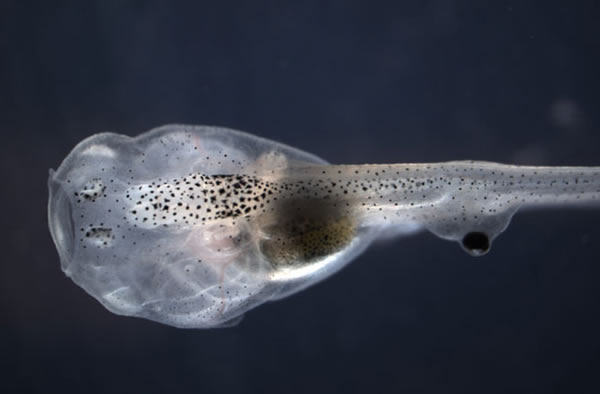Future Forsees Eyes In the Back of Your Head
A "blind" tadpole without its native, normal eyes is able to see using a functioning ectopic eye located on its tail.
Having eyes in the back of one’s head has long been a folksy, well-worn idiom. But for future generations, this phrase may take on a more literal context. Not only could we have eyes in the back of our head, we could have them on our arm, our shoulder – even our derrière.
For the first time ever, scientists have shown that eyes transplanted far outside the head in a vertebrate animal were capable of “seeing,” despite having no direct neural connection to the brain.
Biologists at Tufts University School of Arts and Sciences say this discovery has many implications, especially in the fields of regenerative medicine, sensory augmentation research and bioengineering.
“One of the things that this study showed us is that connecting a sense organ as complex as the eye to the spinal cord is sufficient to confer vision,” Dr. Michael Levin told Discovery News. “So you don’t have to plug in to the actual brain.”
Levin is a professor of biology and director of the Center for Regenerative and Developmental Biology at Tufts University. Along with Dr. Douglas Blackiston, a post-doctoral associate in Levin’s lab, the two co-authored the study “Ectopic Eyes Outside the Head in Xenopus Tadpoles Provide Sensory Data For Light-Mediated Learning,” recently published in the Journal of Experimental Biology.
For the experiment, biologists surgically removed the eyes of donor tadpoles and grafted them onto the posterior of recipient tadpoles, which induced the growth of ectopic – or abnormally placed – eyes. Recipient tadpoles had their natural eyes removed, so only the ectopic, spinal cord-connected eyes remained.
The team developed a computerized visual training system with quadrants of water illuminated by either red or blue LED lights. Administrators issued a mild electric shock to tadpoles swimming in the red quadrant and used a camera-equipped motion tracking system to record the tadpoles’ subsequent movement.
More than 19 percent of the tadpoles with optic spine-connected nerves demonstrated learned responses to the lights. Tadpoles swam away from the red light, while those in the blue light swam naturally.
“That’s really interesting for the regenerative medicine side of things,” Levin said, referring to treating sensory disorders such as blindness. “All of this suggests that connections to the spinal cord might be a really convenient and useful modality, rather than try to plumb into the brain itself.”
However, Levin says this breakthrough doesn’t only apply to cases of damaged or missing sense organs, but could also benefit sensory augmentation.
“You may want to increase your sensory capacity with sensors that normal people usually don’t have,” he said. “This opens the possibility for attaching all sorts of peripherals to your body.”
Levin also notes a long-term objective of applying this technology to robots, giving them an adaptive flexibility that will allow them to continue to function when they’re damaged or altered.
But how is this data transfer possible if the sensory organ is only connected to the spinal cord?
“You can imagine that information that comes from any sensory structure – any part of the body – is tagged in some way that uses a unique identifier,” said Blackiston. "So, the source of that information is not nearly as important as what the brain is sensing.”
Blackiston suggests thinking about this process in terms of television.
A TV "understands that some info is audio data, some of it is visual data and thus sends it to the speakers or screen,” he said. “That’s all coming from one signal – one pipeline – to the central computer or the brain of the TV.”
Levin says this study is part of larger effort in his lab to comprehend the interface between the brain and the changing structure of the body.
“We’re really interested in understanding how the brain may be able to survey the anatomy and get a picture of what the current configuration looks like,” he said. “One hypothesis is that all these organs, in communicating with the nervous system, are passing along metadata that announces their identity and location to the brain.”
Feb 27, 2013 06:00 PM ET by Nic Halverson












